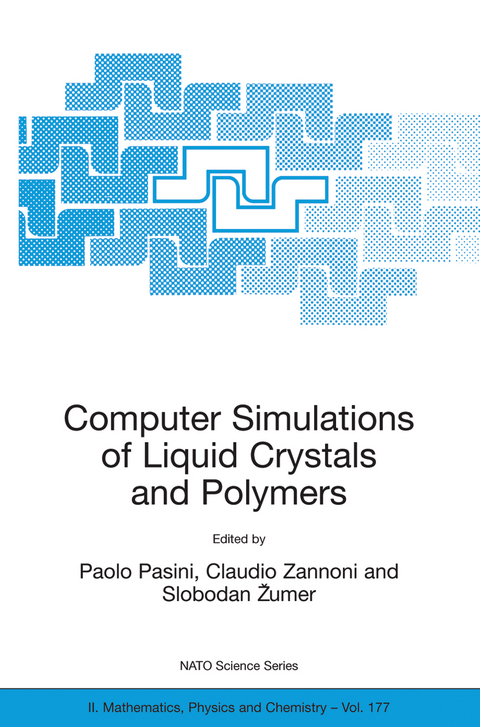
Computer Simulations of Liquid Crystals and Polymers
Springer-Verlag New York Inc.
978-1-4020-2758-1 (ISBN)
Introduction, 1.Polymer-dispersed liquid crystals, 2.The simulation method, 2.1The PDLC simulation model, 2.2 Molecular ordering, 3.2H NMR, 3.1 Orientational fluctuations, 3.2 Translational diffusion.4External field effects, 4.1 Radial droplet, 4.2 Bipolar droplet. 5 Many-droplet sample.6.Conclusions 2.Nematics with dispersed polymer networks: from lattice spin models to experimental observables Introduction.1.Aligning ability of the network.1.1 Planar anchoring.1.2 Homeotropic anchoring: topological defects.1.3 2 NMR spectra. 2 External field-induced switching.2.1 Regular fiber array. 2.2 Irregular fiber array. 2.3 Experimental observables and network irregularity. 3.Pretransitional ordering in the isotropic phase.4 Conclusions. 3. Computer simulations of liquid crystal polymers and dendrimers. Introduction. 1Simulation Models. 1.1 Atomistic Models, 1.2 Simplified models for polymers and liquid crystals, 2.Hybrid Models, 3.Side chain liquid crystalline polymers, 4.Main chain liquid crystalline polymer, 5.Carbosilane liquid crystalline dendrimers, 5.1 Hybrid Gay-Berne/Lennard-Jones model, 5.2 Coarse-grained model, 6.Summary. 4.Monte Carlo simulations of liquids of mesogenic oligomers. Introduction. 1.Trimers with polymethylene spacers, 1.1 Models and methods, 1.2 Thermal behaviour, 1.3 Orientational order in the nematic liquids,1.4 Conformational changes at the nematic/isotropic transition, 2. Dimers of series I, 3. Conclusions. 5. Molecular arrangements in polymer-nanofiller systems.. Introduction. 1.Simulations of dense systems,1.1 Models and methods,1.2 The filler/polymer interface, 1.3 Chain conformation, 1.4Molecular arrangements, 1.5 Predicting the molecular arrangements,2.Simulations of phantom chains, 3. Conclusions. 6. Dissipative particle dynamics approach to nematic polymers. Introduction. 1.Dissipative Particle Dynamics, 2. Methodology, 3.Standard semi-rigid segments, 4.An alternative approach, 5.Summary. 7. Some things we can learn from chemically realistic polymer melt simulations. Introduction, 1.Quantitative Comparison to Experiment, 1.1 NMR Experiments, 1.2 Neutron Scattering Experiments,1.3 Dielectric Relaxation Experiments, 2. Changing the model Hamiltonian, 3. Summary 8. Monte Carlo simulations of semi-flexible polymers, Introduction. 1.State Diagram of a Semi-flexible Chain, 1.1 Mean Field Scaling Theory 1.2 State Diagram, 2.Solutions of Semi-flexible Chains, 3.Summary 9.Macromolecular mobility and internal viscosity. The role of stereoregularity. Introduction 1.Internal viscosity, 2.Recent experimental investigations, 3.Steric hindrance to rotational propagation, 3.1 Isotactic Polystyrene (i-PS), 3.2 Syndiotactic Polystyrene (s-PS), 4.Some concluding remarks on internal viscosity and steric rotational hindrance, 10. Protein adsorption on a hydrophobic graphite surface. Introduction. 1.Short background of theoretical and simulation methods, 2. Simulations details, 3. Initial adsorption stage in the dielectric medium, 4.Final adsorption stage by molecular dynamics in the dielectric medium, 5.Kinetics of surface spreading, 6.Hydration of the adsorbed protein fragments, 7. Conclusions and outlook to future work. 11. Multiscale simulation of liquid crystals. Introduction, 1.A multiscale model for LC-based sensors,1.1 Molecular simulations, 1.2 Dynamic Field Theory, 2.Clusters of particles, 2.1 Mapping of simulation and field theory length scales, 2.2 Sphere/substrate interactions, 2.3Two particle systems,3.Ordering kinetics in a LC-based biosensor, 4.Conclusion 12. Polymer chains and networks in narrow slits.Introduction 1. Compressed polymer networks,1.1A Gaussian chain in a harmonic potential, 1.2 The two-dimensional network, 1.3 Numerical results, 2. Polymer-mediated adhesion, 2.1 The model, 2.2 The transfer matrix, 2.3 Statistical population of loops and bridges, 2.4 Free energy, elastic forces and moduli, 3 Conclusions. 13. Rotation and deformation of polymer molecules in solutions subjected to a shear flow. Introduction, 1.Angular Velocity and Deformation, 2.A Simple Model, 3.Rotation and Deformation, 4.Shear-Induced Chaotic Behavior and Periodic Orbits, 5.Other Thermostats, 6.Concluding Remarks. 14. Regular and chaotic rheological behavior of tumbling polymeric liquid crystals. Introduction, 1.The model equations, 1.1 Relaxation equation for the alignment tensor, 1.2 Constitutive relation for the pressure tensor, 1.3 Scaled variables: alignment tensor and relevant parameters, 1.4Scaled variables: stress tensor, 1.5 Basis tensors and component notation, 1.6 Characteristic solutions for the orientational dynamics, 2.Rheological behaviour, 2.1 Solutions for imposed shear rate and shear stress, 2.2 Isotropic phase and flow aligned nematic, 2.3 Tumbling nematic, 2.4 Nonzero 3. Orbits, 3.1 General remarks, flow aligned state 3.2 Kayaking-tumbling, 3.3 Tumbling, 3.4 Kayaking-wagging 3.5 Chaotic behaviour 4.Conclusions, 15. Parallel computer simulation techniques for the study of macromolecules. Introduction. 1. Parallelisation: the basic concepts, 2. Parallel molecular dynamics: the replicated data approach, 3.Parallel molecular dynamics: the domain decomposition approach, 4. Parallel Monte Carlo, 5.Summary, Index
| Reihe/Serie | NATO Science Series II: Mathematics, Physics and Chemistry ; 177 |
|---|---|
| Zusatzinfo | XVI, 364 p. |
| Verlagsort | New York, NY |
| Sprache | englisch |
| Maße | 160 x 240 mm |
| Themenwelt | Naturwissenschaften ► Chemie ► Organische Chemie |
| Naturwissenschaften ► Chemie ► Physikalische Chemie | |
| Naturwissenschaften ► Physik / Astronomie ► Atom- / Kern- / Molekularphysik | |
| Naturwissenschaften ► Physik / Astronomie ► Festkörperphysik | |
| Naturwissenschaften ► Physik / Astronomie ► Thermodynamik | |
| ISBN-10 | 1-4020-2758-3 / 1402027583 |
| ISBN-13 | 978-1-4020-2758-1 / 9781402027581 |
| Zustand | Neuware |
| Haben Sie eine Frage zum Produkt? |
aus dem Bereich


